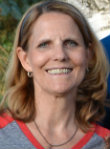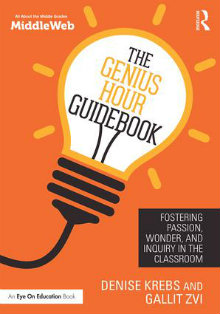How to Make Genius Hour Happen
The Genius Hour Guidebook: Fostering Passion, Wonder, and Inquiry in the Classroom
By Denise Krebs and Gallit Zvi
(Routledge/Eye on Education, 2016 – Learn more)

Young kids are naturally curious. They investigate bugs by digging up dirt and crouching down to get a closer look. Youngsters ask continuous questions seeking answers to something they wonder about.
However, as time passes, it seems many students lose this need to search out answers. Authors and classroom teachers Denise Krebs and Gallit Zvi encourage teachers to bring back the passion of inquiry with Genius Hour. The Genius Hour Guidebook offers a plan to “foster passion, wonder, and inquiry in the classroom.”

Krebs and Zvi offer a plan for teachers who hesitate trying Genius Hour. The opening chapter explains what Genius Hour is and why students need it: “Genius Hour gives students time to find and follow their passion.” The authors acknowledge that change can be scary, but good stuff can happen when we are a bit uncomfortable.
Genius Hour begins with a basic plan.
Step 1: Inspire Your Class – Inspirational videos and picture books are a great starting point. Set up the learning environment so that “students know they’re supported and encouraged to be creative.”
Step 2: Brainstorm with Students – Suggestions in the book include listing the things you love to do and learn, things you are good at, and things you wonder. Wonder Walls or Passion Walls can be displayed to inspire others.
Step 3: Create an Inquiry Question – The authors suggest taking time to teach students the difference between a Google-able question and a thick question. Tips are included for supporting those who can’t come up with a question.
The framework offered in the opening chapter is a guide, but the authors encourage readers to make it their own and personalize the experience. Once the learning environment has been established, Genius Hour is ready to launch. Students follow four steps:
- The Launch: Diving In and Letting Go
- Loosening Deadlines and Sharing Passions
- Helping Kids Make Their Learning Visible
- Teaching about Self-Assessment and Feedback
Letting Go
Teachers are used to being in charge and letting go is difficult. However, the authors stress the importance of letting go and becoming a fellow learner. Guiding students through their research, especially finding good information, is the beginning of the process. Alan November is quoted in the book: “If we only teach one skill to prepare our students to survive in a web-based works, it should be that of critical thinking in the analysis of online information.”
Students are expected to share their newfound learning with the rest of the class in a presentation. Presentations can include slideshows, movies, documentaries, posters, or demonstrations. Students also need to take this experience further by making their learning visible. An authentic audience adds meaning to learning. Blogs and ePortfolios can be shared with the world through the various social networks. Several chapters explain in depth the process of making learning visible, self-assessment/feedback, and challenging students to improve the world.
Lesson Plans and More
The Genius Hour Guidebook may be an easy read, but it is a powerhouse of resources. The authors set a foundation to understand how learning happens during this time, how to guide students through the process, as well as how to assess. Resources and lesson plans are included in the appendix. There is also a companion website which is free to anyone and includes sample materials from the book and other resources.
Denise Krebs and Gallit Zvi have written a complete guidebook that will challenge both the beginning and the expert teacher to think outside of the box and bring passion back to learning.
Sandy Wisneski is a lead teacher at Catalyst Charter Middle School in Ripon, WI. She is the district Webmaster, tech mentor, and yearbook advisor as well as new teacher mentor. Over the past 40 years she obtained her masters in reading, become certified as a Flat Classroom Teacher, a Graphite Certified Teacher and Certified BrainPOP Educator. The summer of 2014 she attended Honeywell Educators @ Space Academy. She enjoys challenging students to “take ownership” for their learning and to be effective digital citizens in the world.





























